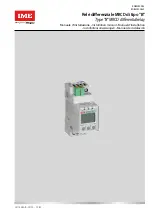
BE1-51/27R - Tests And Adjustments
5-9
NOTE
Due to delays inherent in the test equipment, the time delay may appear to exceed these
limits. This concludes the timed output test.
Relays having instantaneous overcurrent option 1-1 or 1-2 only proceed to the
Instantaneous Overcurrent Test.
All other relays proceed to the voltage restraint test.
NOTE
For relays having three-phase sensing (sensing input type B, C, R, or S) only a single
input phase is connected since this is sufficient for a complete test of the instantaneous
overcurrent sensing and output.
For relays that include neutral sensing (sensing input types E, F, U, W, Y, or Z), this test
includes reconnecting the test output to the neutral sensing terminals for testing the
instantaneous 1 output during neutral sensing.
Step 20. On the appropriate time overcurrent curve chart (Figures 1-2 through 1-70), locate the line
representing 5 times the tap value (from Step 5) where it intersects the particular curve
representing the front panel TIME DIAL (NEUTRAL) setting of 20 (from Step 14). The resulting
time delay value in seconds should be within ±5% of the timer reading [from step 18(2)].
Instantaneous Overcurrent Pickup Test
This test checks the minimum overcurrent pickup points for Instantaneous 1 and (if present) Instantaneous
2 outputs.
Step 1.
Perform the preliminary instructions.
Step 2.
Reconnect the test setup to the INST 1 output terminals 2 and 10 as shown in Figures 5-1 through
5-6. Note that the timer may be removed from the test setup at this time.
Step 3.
Set the TAP selector to A.
Step 4.
Turn the front panel INST 1 control fully CCW to establish a pickup point of 1 times the TAP
selector A setting.
Step 5.
Slowly adjust the test set, increasing the overcurrent threshold toward the value of the front panel
TAP selector A setting until the Instantaneous 1 output relay energizes). Do not disturb this
setting.
RESULT: If the target Type A or B is present:
(a)
The front panel FUNCTION - INST 1 target (if present) will trip.
(b)
The appropriate front panel ELEMENT target A, B, or C (if present) will trip.
Step 6.
Remove input current. Record the test set current setting.
RESULT:
The recorded value should be equal to or less than the front panel TAP selector A
setting for the minimum overcurrent pickup point for the instantaneous 1
overcurrent element.
Step 7.
Reset the relay front panel targets (if present).
Step 8.
Turn the front panel INST 1 control fully CW to establish a pickup point of 40 times the front panel
TAP selector A setting.
Содержание BE1-51/27R
Страница 14: ...BE1 51 27R General Information 1 9 Figure 1 1 Style Number Identification Chart...
Страница 36: ...BE1 51 27R General Information 1 31 Figure 1 38 Timing Type E7 BS 142 Extremely Inverse Drawing No 99 1097...
Страница 54: ...2 2 BE1 51 27R Human Machine Interface Controls And Indicators Figure 2 1 Location of Controls and Indicators...
Страница 59: ...3 2 BE1 51 27R Functional Description Figure 3 1 Functional Block Diagram...
Страница 69: ...BE1 51 27R Installation 4 7 Figure 4 8 Typical Internal Diagram Sensing Input Type M or N...
Страница 76: ...4 14 BE1 51 27R Installation Figure 4 14 Relay Signals and Current Pickup Example For 3 Phase Fault XE 0 65 X D...










































